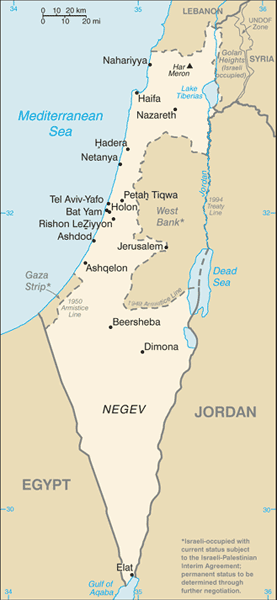
I would like to extend a warm welcome to Kiva’s first partner in Israel – Koret Israel Economic Development Funds (KIEDF). I worked in Tel Aviv with KIEDF in November and quickly realized that Israel is a fascinating country for a variety of historical, cultural, religious, political and economic reasons. Over the following weeks, I will provide Kiva community a closer look at KIEDF and its accomplishments, but will dedicate this blog post to a profile of Israel and the need for further development of microfinance in the country.
Geography
The modern State of Israel was created in 1948 and is situated on the coast of the Mediterranean Sea, bordering Lebanon and Syria in the north, West Bank and Jordan in the east, Gaza and Egypt in the southwest. Israel has a total area of 22,072 sq km and is slightly smaller than New Jersey.
Population
Israel’s total population is about 7.65mm people (2010 estimate); about 80% of population is Jewish, with Arab citizens comprising the remaining 20%. The official languages are Hebrew and Arabic, though some often joke that Russian is official too.
Economy
According to the 2009 estimates, Israel’s GDP was $206.9bn, coming in at # 51 in the world, between Portugal and Denmark. Israel boasts a great number of high tech companies and start-ups (second only to the Silicon Valley), and its engineers are renowned for their work on solar energy technology. The cell phone was actually developed by Motorola in Israel!
In 2010, Israel ranked 17th among the world’s most economically developed nations in IMD’s World Competitiveness Yearbook rankings.
So what does this developed country have to do with microfinance you may ask? It is the same question that was raised when Kiva started its partnerships with MFIs in the United States, the answer is similar – the benefits of capitalism and financial services do not reach all the corners of the country equally.
Even though Israel’s 2009 Gross National Income per capita (GNI) was $25,740, poverty remains a serious issue among the country’s diverse population, especially after the 2008 global financial crisis. According to the National Insurance Institute’s Annual Poverty Report for 2009, 435,100 families (20.5%) and 1,774,800 Israelis (25%) were living below the poverty line in 2009 (monthly income of NIS 2,268 per person or NIS 5,807 for a family of four).
The report also highlighted that the Haredi (ultra-Orthodox Jews) and Arab communities were facing sharp increases in poverty levels. Some of these populations live in areas in need of further economic development, like the Negev Desert, and would benefit from the creation of socially appropriate, independent income generating activities. Since only a very small portion of the Israeli banking sector is directed at small and micro businesses that could exist in underdeveloped areas of Israel, the microfinance efforts in the country are focused on providing financial services to these low income populations. KIEDF’s SAWA program has been giving out loans and providing business training classes to the low income communities for the past 4 years with great success and it is pleasure to support their efforts.
Please stay tuned for the next blog specifically on the SAWA program. In the meantime, you can show your support for KIEDF loans here and be one of the first Kiva lenders to join the KIEDF Lending Team here!















